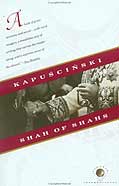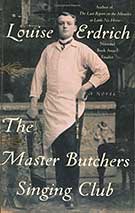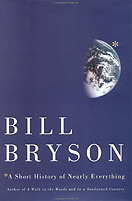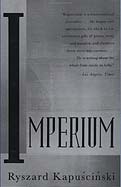
In Shah of Shahs Polish journalist Ryszard Kapuscinski turns his focus to the former Shah of Iran, the CIA supported dictator whose oppressive regime led to the revolution that took Americans hostage in their own embassy, caused the shah’s exile, and resulted in the fundamentalist Islamic government that runs Iran today. Kapuscinski published this book in 1982, just a few years after the revolution. In his unique style Kapuscinski weaves history, stories of individuals, and his own observations and interpretations.
It seems as if in every oppressive regime, there is a police authority, a spy network that detains and tortures anyone suspected of not being loyal to the ruling regime. In Iran, that group of thugs was the Savak.
Continue reading →

The Curious Incident of the Dog in the Night-Time is told in the first person by Christopher John Francis Boone, a 15 year old autistic boy, who sets off on a detective mission to discover who killed his neighbor’s dog. Christopher counts forward in prime numbers, can’t tolerate the colors yellow or brown, avoids strangers, is easily overwhelmed by noise or crowds, and always tells the truth.
We don’t often get a glimpse into the minds and worlds of people so different from ourselves. Author Mark Haddon takes us on a touching journey of how this boy’s world unravels and comes together again as he bumps up against the very real human failings of those closest to him. We feel his anguish and also the comfort he finds in his world of abstract problem solving. The book has several mind-stumping math problems, that Christopher delights in solving for us. One in particular, the Monty Hall problem, was really annoying. It’s the kind of problem that makes you sit down, take out a pen and paper and try to make sense of it. But you can’t. Or most people can’t. I think that is part of the interesting charm of this book. We the readers are as closed off to the world which Christopher inhabits, as he is to our world. As smart as I was in math, these problems confused me, made my brain hurt. As brilliant as Christopher is, it takes every ounce of his mental focus to take a simple subway ride.
Highly recommended.

That Louise Erdrich likes to tell stories becomes obvious from the reading of her novel The Master Butchers Singing Club. She never races through a tale, but takes her time, dissecting every nuance in delicious detail. The book’s central character is Delphine, whom we meet as she is returning home to Argus, North Dakota in the early 1930s with her balancing act partner Cyprian to care for her father, the town drunk. Delphine is a survivalist – a hard working, tough love, feet-firmly-planted-on-the-ground woman. She befriends Eva, the wife of the local butcher, Fidelis Waldvogel, who had immigrated to Argus from Germany after the first world war. Fidelis starts a singing club, the members of which make up many of the contributing characters of the story.
Continue reading →

What a howler. Reminiscent of Mickey Spillane, Carl Hiassen’s Skinny Dip starts with crooked sleeze-ball Charles Perrone throwing his wife off a cruise ship miles away from the coast of Florida. Unbeknownst to Chaz, his wife Joey, was a champion swimmer and athlete in college, and turning her fall into a dive, survives the fall, swims to near exhaustion, eventually latches on to a floating bale of marijuana, and is picked up out of the ocean by a retired cop Mick Stranahan. Joey doesn’t understand why Chaz tried to kill her and spends the bulk of this hilarious story with Stranahan figuring out why and taking revenge by driving her husband crazy. The book is filled with great character sketches – Tool, a pain-killer addicted hired thug who gets reformed by the terminally ill old lady whose meds he tried to steal, Red Hammernut, the agribusiness tycoon who is paying off Chaz to falsify water quality records so he can keep his polluting enterprise up and running, and Karl Rolvaag, the homicide detective who keeps two albino pythons and when they escape is disturbed when the yappy dogs of neighbors go missing.
Continue reading →

If only all science books were as entertaining as Bill Bryson’s A Short History of Nearly Everything. Bryson explains the major scientific theories known to man with masterful storytelling skills. Weaving in richly researched details on the lives and characteristics of the foremost historical scientific figures, Bryson discourses on everything from the big bang theory and quantum physics, to paleontology and plate tectonics. As he put it, the book is about “…how we went from there being nothing at all to there being something, and then how a little of that something turned into us, and also what happened in between and since.” Not just detailing what we know, Bryson describes how we learned what we now know.
Continue reading →

Writing as a correspondent for various Polish journals and press agencies over several decades, Ryszard Kapuscinski travelled extensively through Africa, Latin America, and the former Soviet Union, documenting brutal conflicts and ravaged countries. Ryszard has a poetic ability to delve underneath the surface of geopolitics and reveal stories at a human level.
In Imperium, Kapuscinski covers the human experience in the territories of the former Soviet Union, starting with his remembrances as a young boy in Poland in 1939, hungry and wondering in quiet fear as his friends got deported, presumably to Siberia. In the 50s and 60s, and then again after Perestroika, Ryszard travels to the far flung outposts of former Soviet territories, reflecting upon the after affects of Stalin and later the dramatic changes from the disintegration of the Soviet empire.
Continue reading →





